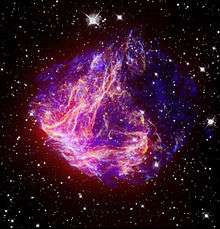LMC N49
Coordinates: ![]() 05h 26m 01.00s, −66° 05′ 06.0″
05h 26m 01.00s, −66° 05′ 06.0″
| Supernova remnant | |
|---|---|
 | |
| Observation data: J2000.0 [1] epoch | |
| Right ascension | 05h 26m 01.00s [1] |
| Declination | −66° 05′ 06.0″ [1] |
| Distance | 160,000[2] ly |
| Physical characteristics | |
| Dimensions | 75 ly across[2] |
| Designations | LMC N49,[3][1] PKS 0525-66,[3][1] PKS B0525-661,[3][1] PKS J0525-6604,[3][1] SNR J052559-660453[3][1] |
| Wikimedia Commons has media related to N49. |
N49 or LMC N49[3] (PKS 0525-66,[1][3] PKS B0525-661,[3] PKS J0525-6604,[3] SNR J052559-660453[1]) is the brightest supernova remnant in the Large Magellanic Cloud, approximately 160,000 light-years from Earth. It has been assessed to be roughly 5,000 years old.[2]
The latest pictures of N49 by the Chandra X-ray Observatory have revealed a bullet-shaped object traveling at about 5 million miles an hour away from a bright X-ray and gamma-ray point source, probably a neutron star with an extremely powerful magnetic field, known as a soft gamma repeater.[2] A particularly strong gamma-ray burst from LMC N49 was detected on March 5, 1979.[4]
References
- 1 2 3 4 5 6 7 8 9 10 "SNR J052559-660453 -- SuperNova Remnant". SIMBAD.
- 1 2 3 4 Chandra X-ray Observatory (2010-05-24). "N49: Stellar Shrapnel Seen in Aftermath of Explosion". Retrieved 2015-10-15.
- 1 2 3 4 5 6 7 8 9 "PKS 0525-66". NASA/IPAC Extragalactic Encyclopedia.
- ↑ "N49, an asymmetric supernova remnant in the LMC". 2012-08-30. Retrieved 2015-10-15.
- Harvard-Smithsonian Center for Astrophysics, "N49: A supernova remnant in the Large Magellanic Cloud"
This article is issued from Wikipedia - version of the 10/16/2015. The text is available under the Creative Commons Attribution/Share Alike but additional terms may apply for the media files.